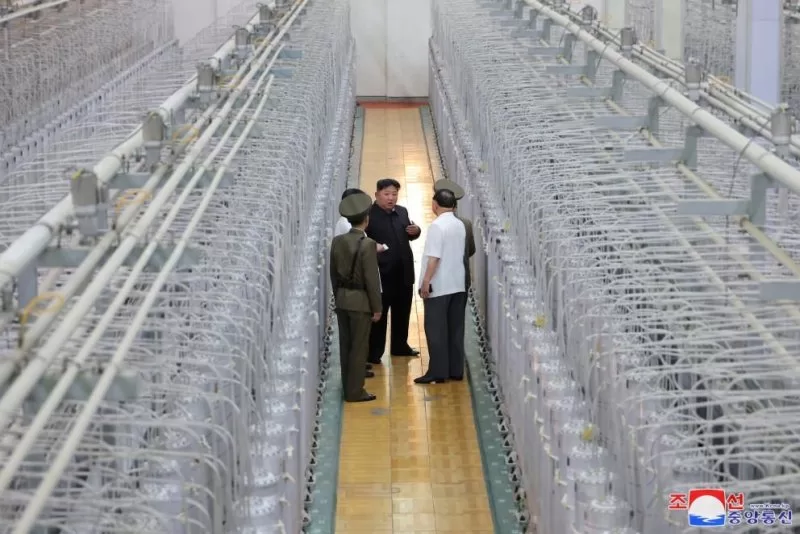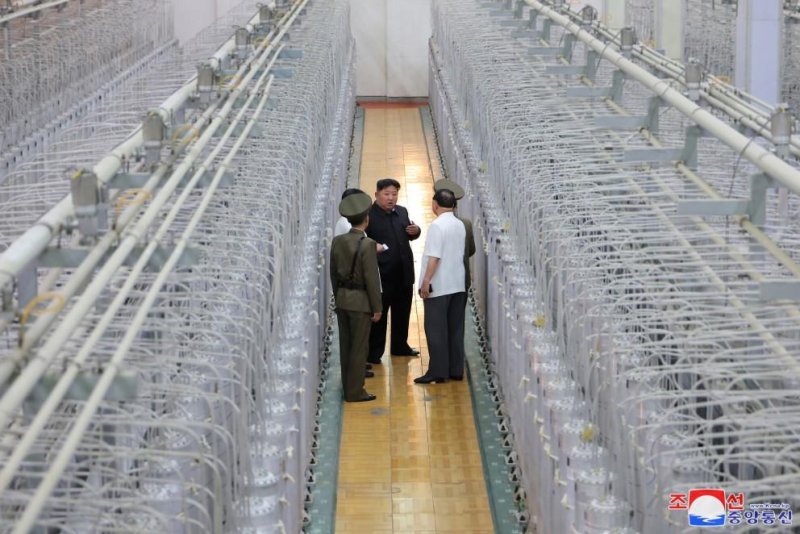North Korean leader Kim Jong Un inspected a uranium enrichment facility and called for an increase in the number of centrifuges to “exponentially” expand the country’s nuclear arsenal, state-run media reported Friday. Photo by KCNA/UPI
SEOUL, Sept. 12 (UPI) — North Korean leader Kim Jong Un inspected a uranium enrichment facility and called for an increase in the number of centrifuges to “exponentially” boost the isolated regime’s nuclear arsenal, state media reported Friday.
Kim toured the Nuclear Weapons Institute along with high-ranking party official Hong Sung Mu, state-run Korean Central News Agency reported, without specifying the location of the facility or date of the visit.
Photos accompanying the report showed Kim walking among long rows of cylindrical centrifuges inside an industrial warehouse — the first images the North has released of a facility to produce fissile material for nuclear weapons, which is banned under United Nations Security Council resolutions.
Kim “acquainted himself with the production of nuclear warheads and current nuclear materials and set forth important tasks for long-term plan for increasing the production of weapon-grade nuclear materials,” KCNA reported.
“He stressed the need to further augment the number of centrifuges in order to exponentially increase the nuclear weapons for self-defense,” the report added.
In 2022, North Korea passed a law officially declaring itself a nuclear state with the right to conduct pre-emptive strikes — a decision Kim Jong Un called “irreversible.”
Friday’s display of its highly enriched uranium, or HEU, facility, is the latest sign that North Korea has no intention of turning back on its nuclear ambitions, Park Won-gon, professor of North Korean Studies at Ewha Womans University in Seoul, said.
“Kim Jong Un’s very clearly sending a message, especially to the United States,” Park told UPI.
“Showing off this kind of HEU facility means that North Korea is never going to have any intention to give up their nuclear program,” Park said. “This is a very clear political message, that the United States should accept North Korea as a de facto nuclear weapon state. That starts future negotiations vis-a-vis arms control, not the denuclearization of North Korea.”
It is unclear whether the facility is at North Korea’s main Yongbyon nuclear complex, which was last visited by outside observers in 2010, or a newer site. The North is believed to have centrifuges in other locations including its Kangson nuclear complex near Pyongyang.
In June, International Atomic Energy Agency Director General Rafael Grossi said that the North had finished construction on a new annex at Kangson.
“The Kangson Complex shares infrastructure characteristics with the reported centrifuge enrichment facility at Yongbyon,” Grossi said in a statement to the IAEA board of governors.
Seoul’s Unification Ministry, which oversees inter-Korean affairs, condemned the North for disclosing the uranium enrichment facility, calling its development of nuclear weapons a clear violation of U.N. Security Council resolutions.
“North Korea must clearly recognize that under no circumstances will we and the international community tolerate North Korea’s possession of nuclear weapons,” ministry spokesman Koo Byung-sam told reporters at a press briefing Friday.
“I give a stern warning that any nuclear threat or provocation by North Korea will be met with an overwhelming and strong response from our government and military, based on the integrated extended deterrence system of the steadfast South Korea-U.S. alliance,” Koo said.
Kim’s visit to the facility comes on the heels of a 76th founding anniversary address he gave earlier this week, calling for a major nuclear buildup.
A recent study by the Stockholm International Peace Research Institute estimated that the North has assembled around 50 warheads and possesses enough fissile material for up to 90 warheads.
North Korea last conducted an underground nuclear test in 2017, although Seoul and Washington have assessed that it has long been ready to conduct its seventh overall detonation.
Last week, South Korean officials suggested that North Korea may plan to conduct major provocations, such as a nuclear test or intercontinental ballistic missile launch, around the upcoming U.S. presidential election.
The North, and Kim Jong Un in particular, has been a topic in the race between former President Donald Trump — who held two high-profile summits with Kim and met him briefly a third time at the DMZ — and Vice President Kamala Harris.
Trump touted his relationship with Kim during his acceptance speech at the Republican National Convention in July, saying “I think he misses me.”
“We stopped the missile launches from North Korea,” Trump said. “Now, North Korea is acting up again. But when we get back, I get along with him. He’d like to see me back too.”
Harris, meanwhile, criticized Trump’s ties with Kim during their presidential debate on Tuesday.
“It is well known [Trump] exchanged love letters with Kim Jong Un,” she said. “And it is absolutely well known that these dictators and autocrats are rooting for you to be president again because they’re so clear they can manipulate you with flattery and favors.”
Tensions have remained high on the Korean Peninsula over the past few years amid a steady stream of weapons tests and bellicose rhetoric from the North and a hardline stance from Seoul.
The South’s military announced that North Korea launched several short-range ballistic missiles on Thursday for the first time in more than two months. KCNA reported Friday that the launch was a test of a new 600mm multiple launch rocket system.

